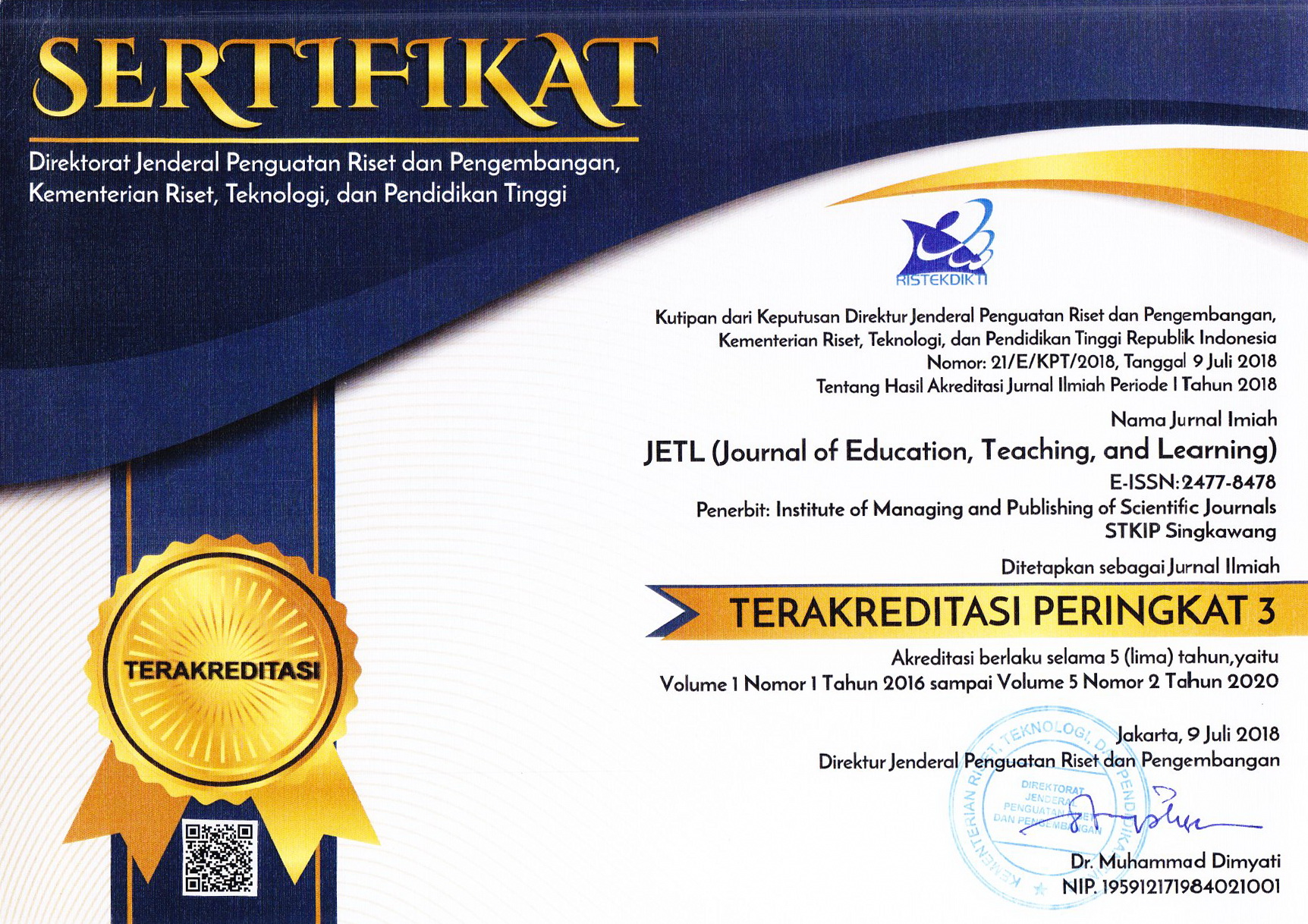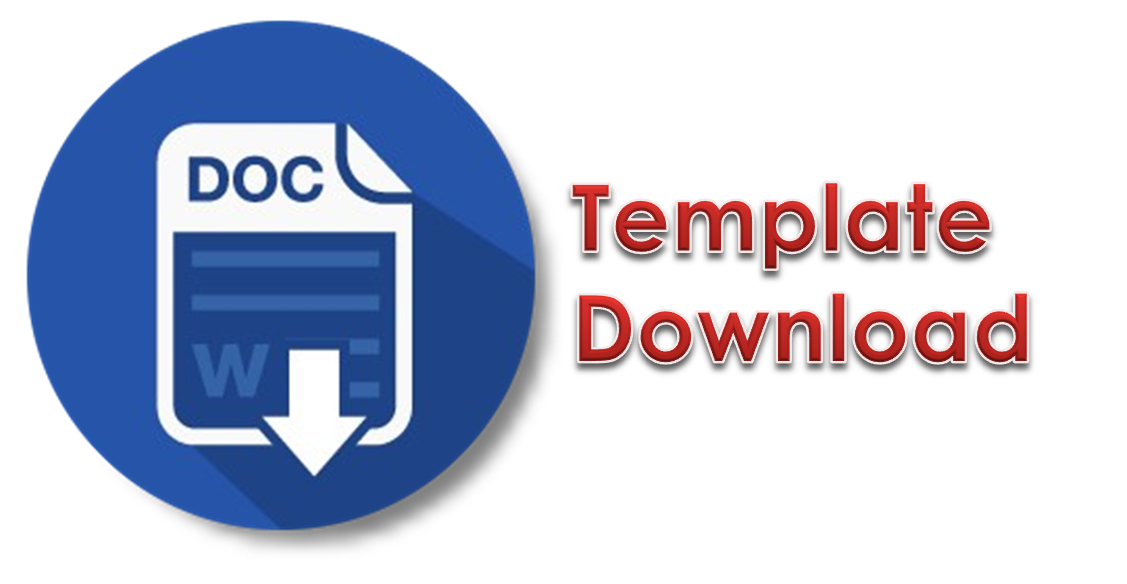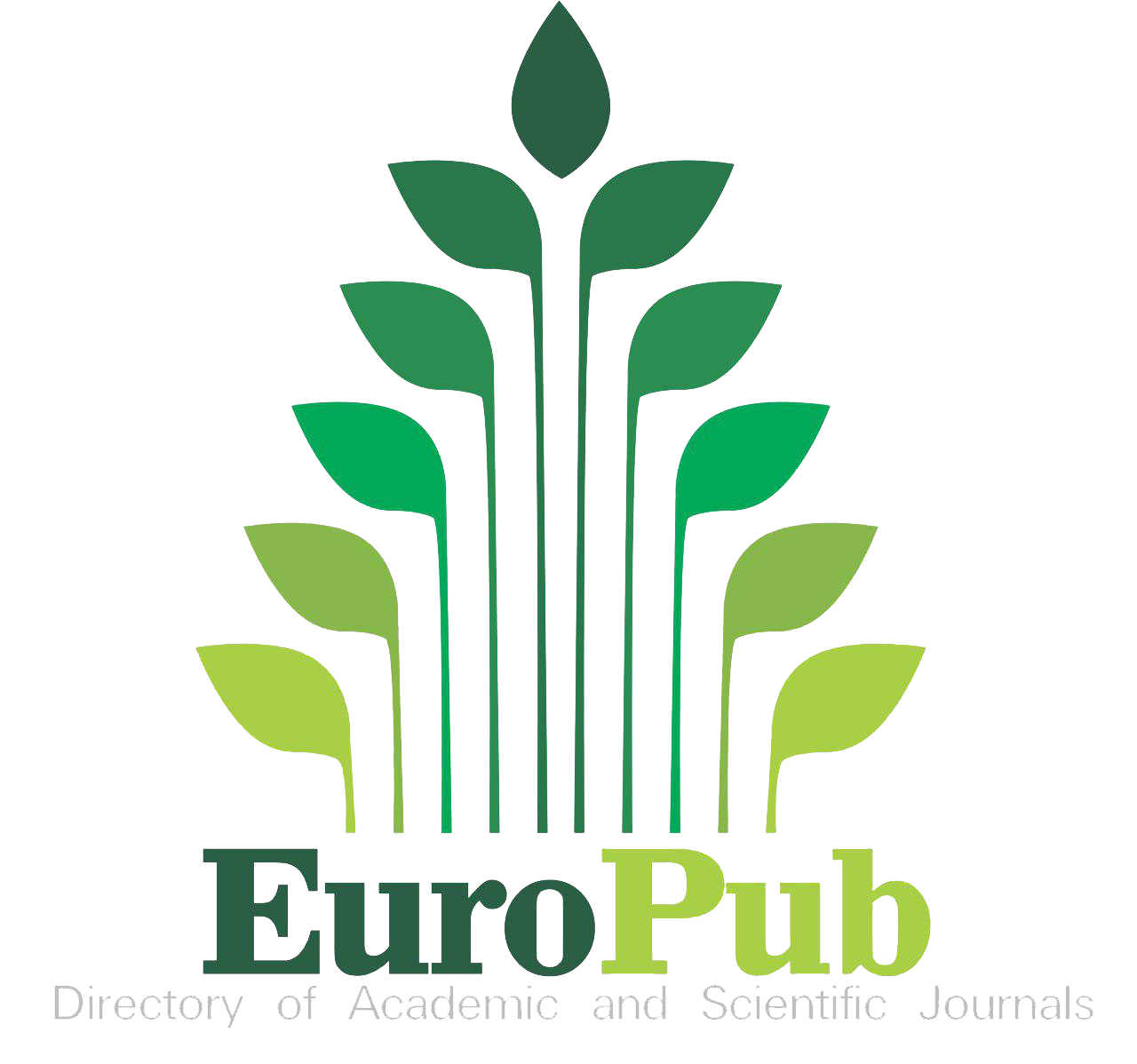The Development of Microlearning-Based on Teaching Materials to Increase Students’ Ecoliteracy
Abstract
This study aims to (1) determine the validity of microlearning-based teaching materials, (2) determine the response of teachers and students to microlearning-based teaching materials, and (3) investigate the effect of microlearning-based teaching materials on students’ ecoliteracy. The research method used was mixed research method or a combination of qualitative and quantitative approaches. The sample in this study were 63 students and 3 geography teachers at SMA Negeri 1 Belitang. The microlearning-based teaching materials developed are podcasts and videos. The results showed that (1) the results of validation tests by material experts on video teaching materials and microlearning-based podcasts received a very high score of 81%, while the results of validation tests by media experts on video teaching materials received a very high score of 94%, and podcasts received a very high score of 96%; (2) the geography teachers’ responses to video teaching materials was very good with a score of 91.6%, and to podcast teaching materials were also very good with a score of 82.5%. While the responses of students to video teaching materials was very good with a score of 86.1%, and to podcast teaching materials were also very good with a score of 81.8%; (3) based on the results of the independent sample T-test, it is known that (a) there is an effect of using microlearning-based video teaching materials on students’ ecoliteracy, (b) there is no effect of using microlearning-based podcast teaching materials on students’ ecoliteracy, and (c) microlearning-based video teaching materials have higher effectiveness than microlearning-based podcast teaching materials in influencing students’ ecoliteracy.
Keywords
Full Text:
PDFReferences
Ajoke, A. R. (2017). The importance of instructional materials in teaching english as a second language. International Journal of Humanities and Social Science Invention, 6(9), 36–44. www.ijhssi.org
Anantasari, W., Jufri, & Aos, H. S. (2015). EFEKTIFITAS PENGGUNAAN MEDIA VIDEO BERBASIS LINGKUNGAN (MVBL) DALAMMENINGKATKAN PERILAKU POSITIF ANAK TERHADAP LINGKUNGAN. Jurnal Penelitian Pendidikan IPA (JPPIPA), 1(1), 49–56. https://doi.org/10.3969/j.issn.1008-0813.2015.03.002
Bolliger, D. U., Supanakorn, S., & Boggs, C. (2010). Impact of podcasting on student motivation in the online learning environment. Computers and Education, 55(2), 714–722. https://doi.org/10.1016/j.compedu.2010.03.004
Booth, P. R., & Sinker, C. A. (1979). The teaching of ecology in schools. Journal of Biological Education, 13(4), 261–266. https://doi.org/10.1080/00219266.1979.9654266
BPS. (2016). Statistik Lingkungan Hidup Indonesia 2016. In Statistik Lingkungan Hidup Indonesia 2020. Jakarta: Badan Pusat Statistik.
Brame, C. J. (2016). Effective educational videos: Principles and guidelines for maximizing student learning from video content. CBE Life Sciences Education, 15(4), es6.1-es6.6. https://doi.org/10.1187/cbe.16-03-0125
Capra, F. (1997). The Web of Life: A New Scientific Understanding of Living Systems. New York: DOUBLEDAY.
Creswell, J. . (2014). Design Research Quantitative, Quaklitative dan Mixed Methods Aproaches, John. W, Creswell. SAGE Publication.
Cutter-Mackenzie, A., & Smith, R. (2003). Ecological literacy: The ‘missing paradigm’ in environmental education (part one). Environmental Education Research, 9(4), 497–524. https://doi.org/10.1080/1350462032000126131
Davis, L. S., & León, B. (2018). New and old narratives: Changing narratives of science documentary in the digital environment. Communicating Science and Technology through Online Video: Researching a New Media Phenomenon, 55–63. https://doi.org/10.4324/9781351054584
Depdiknas. (2008). Panduan Pengembangan Bahan Ajar. In Depdiknas Jakarta. http://file.upi.edu/Direktori/FIP/JUR._KURIKULUM_DAN_TEK._PENDIDIKAN/194601291981012-PERMASIH/PENGEMBANGAN_BAHAN_AJAR.pdf
Dolasinski, M. J., & Reynolds, J. (2020). Microlearning: A New Learning Model. Journal of Hospitality and Tourism Research, 44(3), 551–561. https://doi.org/10.1177/1096348020901579
Dunlap, R. (2008). The new environmental paradigm scale: From marginality to worldwide use. Journal of Environmental Education, 40(1), 3–18. https://doi.org/10.3200/JOEE.40.1.3-18
Finkler, W., & Leon, B. (2019). The power of storytelling and video: a visual rhetoric for science communication. Journal of Science Communication, 8(5), 55.
Hadijah, S. (2018). Analisis Respon Siswa Dan Guru Terhadap Penggunaan Multimedia Interaktif Dalam Proses Pembelajaran Matematika. Jurnal Numeracy, 2(2), 176–183. http://ieeeauthorcenter.ieee.org/wp-content/uploads/IEEE-Reference-Guide.pdf%0Ahttp://wwwlib.murdoch.edu.au/find/citation/ieee.html%0Ahttps://doi.org/10.1016/j.cie.2019.07.022%0Ahttps://github.com/ethereum/wiki/wiki/White-Paper%0Ahttps://tore.tuhh.de/hand
Hew, K. F. (2009). Use of Audio Podcast in K-12 and Higher Education: A Review of Research Topics and Methodologies. Educational Technology Research and Development, 57(3), 333–357.
Hollweg, K. S., Taylor, J. R., Bybee, R. W., Marcinkowski, T. J., & ... (2011). Developing a framework for assessing environmental literacy. Washington, DC: North American Association for Environmental Education. http://www.naaee.net
Kamilali, D., & Sofianopoulou, C. (2015). Microlearning as innovative pedagogy for mobile learning in MOOCs. Proceedings of the 11th International Conference on Mobile Learning 2015, ML 2015, 127–131.
KLHK. (2021). Deforestasi Indonesia Tahun 2019-2020. Direkorat Inventarisasi dan Pemantauan Sumber Daya Hutan. Direktorat Jenderal Planologi Kehutanan dan Tata Lingkungan. Kementerian Lingkungan Hidup dan Kehutanan.
Lestari, K. P., & Benardi, A. I. (2020). Perbedaan Hasil Belajar Siswa dengan Model Pembelajaran Blended Learning Berbasis Edmodo dan Model Pembelajaran di Kelas Reguler Pada Mata Pelajaran Geografi SMA Negeri 1 Pamotan Tahun Ajaran 2019/2020. Edu Geography, 8(3), 232–237.
Lewinsohn, T. M., Attayde, J. L., Fonseca, C. R., Ganade, G., Jorge, L. R., Kollmann, J., Overbeck, G. E., Prado, P. I., Pillar, V. D., Popp, D., da Rocha, P. L. B., Silva, W. R., Spiekermann, A., & Weisser, W. W. (2015). Ecological literacy and beyond: Problem-based learning for future professionals. Ambio, 44(2), 154–162. https://doi.org/10.1007/s13280-014-0539-2
Margono, B. A., Potapov, P. V., Turubanova, S., Stolle, F., & Hansen, M. C. (2014). Primary forest cover loss in indonesia over 2000-2012. Nature Climate Change, 4(8), 730–735. https://doi.org/10.1038/nclimate2277
McBeth, W., & Volk, T. (2009). The national environmental literacy project: A baseline study of middle grade students in the United States. Journal of Environmental Education, 41(1), 55–67. https://doi.org/10.1080/00958960903210031
McBride, B. B., Brewer, C. A., Berkowitz, A. R., & Borrie, W. T. (2013). Environmental literacy, ecological literacy, ecoliteracy: What do we mean and how did we get here? Ecosphere, 4(5). https://doi.org/10.1890/ES13-00075.1
Mohammed, G. S., Wakil, K., & Nawroly, S. S. (2018). The Effectiveness of Microlearning to Improve Students’ Learning Ability. International Journal of Educational Research Review, 3(3), 32–38. https://doi.org/10.30659/e.1.1.68-75
Muthukrishnan, R. (2019). Using Picture Books to Enhance Ecoliteracy of First-Grade Students. The International Journal of Early Childhood Environmental Education, 6(2), 19.
Nugraha, H., Rusmana, A., Khadijah, U., & Gemiharto, I. (2021). Microlearning Sebagai Upaya dalam Menghadapi Dampak Pandemi pada Proses Pembelajaran. JINOTEP (Jurnal Inovasi Dan Teknologi Pembelajaran): Kajian Dan Riset Dalam Teknologi Pembelajaran, 8(3), 225–236. https://doi.org/10.17977/um031v8i32021p225
Orr, D. W. (1992). Ecological literacy: Education and the transition to a postmodern world. State University of New York Press.
Prastowo, A. (2015). Panduan kreatif membuat bahan ajar inovatif. Yogyakarta: Diva Press.
Priyanti, R. P., Hidayah, N., Rosmaharani, S., Nahariani, P., Asri, Mukarromah, N., & Mundakir. (2019). Community Preparedness in Flood Disaster: A Qualitative Study. International Quarterly of Community Health Education, 40(1), 67–68. https://doi.org/10.1177/0272684X19853169
Qadriani, N. L., Hartati, S., & Dewi, A. (2021). Pemanfaatan Youtube dan Edpuzzle sebagai Media Pembelajaran Daring Berbasis Video Interaktif. Jurnal Pemberdayaan Masyarakat Universitas Al Azhar Indonesia, 4(1), 1. https://doi.org/10.36722/jpm.v4i1.841
Resosudarmo, B. P. (2012). Implementing a national environmental policy: Understanding the “success” of the 1989-1999 integrated pest management programme in Indonesia. Singapore Journal of Tropical Geography, 33(3), 365–380. https://doi.org/10.1111/sjtg.12006
Roziqin, A., Sumiarto, R. S., & Aziz, F. N. (2021). Mental Revolution , Youth , and Environmental Issues in Indonesia. 1(12), 1191–1201. https://doi.org/10.17977/um063v1i112021p1191-1201
Salvia, A., Leal Filho, W., Brandli, L., & Griebeler, J. (2019). Salvia , AL and Leal Filho , W and Brandli , LL and Griebeler , JS ( 2019 ) As- sessing research trends related to Sustainable Development Goals : local Downloaded from : http://e-space.mmu.ac.uk/621845/ Version : Accepted Version Publisher : Elsevier DOI. Journal of Cleaner Production, 2008, 841–849.
Singh, R. L., & Singh, P. K. (2017). Global Environmental Problems. In R. L. Singh (Ed.), Principles and Applications of Environmental Biotechnology for a Sustainable Future (pp. 13–41). Springer Singapore. https://doi.org/10.1007/978-981-10-1866-4_2
Smithwick, E., Baxter, E., Kim, K., Edel-Malizia, S., Rocco, S., & Blackstock, D. (2018). Interactive Videos Enhance Learning about Socio-Ecological Systems. Journal of Geography, 117(1), 40–49. https://doi.org/10.1080/00221341.2017.1374433
Susilana, R., Fadillah, A. F., Ardiansah, Rullyana, G., Ramdani, Sutisna, M. R., Hadiapurwa, A., & Mulyadi, D. (2020). Pengembangan Micro Learning untuk Konten Pembelajaran Daring. Bandung: FKIP UPI.
Torgerson, C., & Lannone, S. (2019). Designing Microlearning. ATD Press.
Zhang, D. (2005). Interactive Multimedia-Based E-Learning : A Study of. THE AMERICAN JOURNAL OF DISTANCE EDUCATION, 19(3), 149–162. https://doi.org/https://doi.org/10.1207/s15389286ajde1903_3
DOI: http://dx.doi.org/10.26737/jetl.v8i2.3568
Refbacks
- There are currently no refbacks.

This work is licensed under a Creative Commons Attribution-NonCommercial 4.0 International License.
Published by:
Institute of Managing and Publishing of Scientific Journals STKIP Singkawang
Sekolah Tinggi Keguruan dan Ilmu Pendidikan (STKIP) Singkawang
Address : STKIP Singkawang, Jalan STKIP - Kelurahan Naram Singkawang, Kalimantan Barat, INDONESIA, 79251
No. Telp. : +62562 420 0344
No. Fax. : +62562 420 0584
JETL (Journal of Education, Teaching, and Learning)
e-ISSN : 2477-8478
p-ISSN : 2477-5924

Editor in Chief Contact: [email protected] / Wa: +6282142072788
Publisher Contact: [email protected] / Wa: +6282142072788
Management Tools
JETL Indexed by:
JETL (Journal of Education, Teaching, and Learning) is licensed under a Creative Commons Attribution-NonCommercial 4.0 International License.











